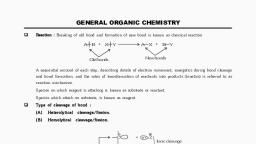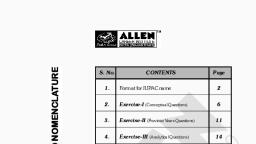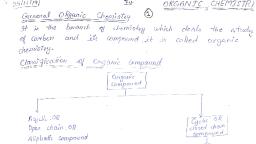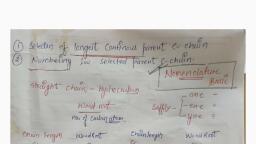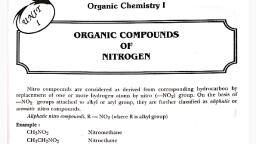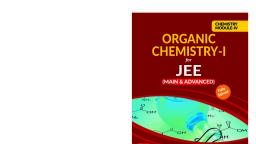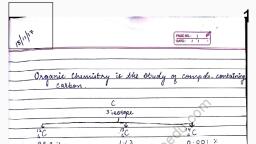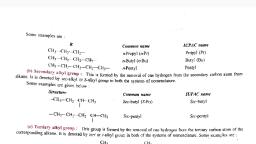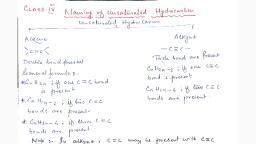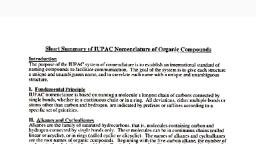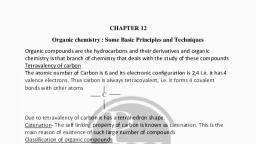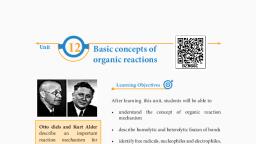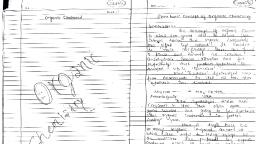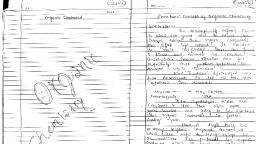Page 1 :
NOMENCLATURE OF ORGANIC COMPOUNDS, , , HISTORY :, In 1675, Nicholas Lemery had devided chemical substances into 3 parts., (i), , Mineral substance : which are obtained from minerals. eg. gold, silver, iron etc., , (ii), , Vegetable substance : which are obtained from vegetables. eg. sugar, citric acid etc., , (iii), , Animal substance : which are obtained from animals. eg. albumin, gilatin etc., After some time when many of the chemical substance were discovered, it was found that some of them, can be obtained from both vegetables and animals. So this classification was failed. So chemical substance, were then divided into two parts :, , (i), , Organic compounds :, , which are obtained from living organism., , (ii), , Inorganic compounds : compounds which are obtained from any other sources except living organisms., , VFT(Vital Force T heor y) : By Berzelius i n 1815. Upto 1815, any organic compound could not be, synthesized in lab. So Berzelius suggested that there is a mysterious force in living organisms which was named, as Vital Force and said that organic compounds cannot be synthesized in lab. This theory was called as VFT., But in 1828 a German scientist Wholar synthesized an organic compound in lab. Which was 'urea'. So VFT, was failed. Urea was synthesized in lab by heating of Ammonium cyanate (NH4CNO)., , NH2 C NH2, NH4 CNO , Re arrangement, O, , Ammonium cyanate, , Urea, , Organic Compounds : Hydrocarbons and their derivatives are called as organic compounds., Ex : Why are organic compounds found in larger no.? or Why are they studied as a separate subject ?, Sol. (i), , Catenation Property : Carbon atom has a property by which it can join with other C–atoms and form, a long chain or a ring of different size and shapes.If covalency of atom is more, then catenation property, is also more., , , , (ii), , Organic compound shows isomerism., , (iii), , Exhibits Homologous Series., , (iv), , Same Empirical Formulae., , (v), , Polymerisation., , Characteristics of C-Atoms, (a), , Tetra valency : Atomic number of carbon atom is 6 and it have four valency electrons so C-Atom is, tetravalent. It is explained by promotion rule, , 2s, , 2p, , In ground state (here covalency of carbon is 2), First excited state (here covalency of carbon is 4), , Available for bond formation, (b), , Tendency to form multiple bonds : Carbon atom forms following type of bonds, such as, , C, , C, , ,, , C, , C, , ,, , C, , C, , ,, , C, , C, , C
Page 2 :
(c), , Tetrahedral shape : T he four covalent bond are directed, towards the four corners of a regular tetrahedron, , C, , 109°28', , Bond angle 109 0 28' or 109.5', , (d), , Catenation : Self linking property of C-atom is known as catenation. It is responsible for the variety, and large number of organic compounds. It may also give rise to open chain and closed chain nature, of compounds. Bond energy for catenation of C is maximum., , Bond energy in Kcal :, , (e), , Hybridisation, , :, , C—C, , Si—Si, , N—N, , P—P, , 85, , 54, , 39, , 50, , The orbitals of different shape but almost of equal energies blend up to give the, , same number of new orbitals of another shape and of identical energies., Str uc tu re, , & bonds, , Hybridisation, , Bond, , angle, , Shape, , 4,0, , sp 3, , 109°28', , Tetrahedral, , 3,1, , sp 2, , 120°, , Planar (Trigonal), , C, , 2,2, , sp, , 180°, , Linear, , C, , 2,2, , sp, , 180°, , Linear, , C, , C, , - (sigma) bonds : The molecular orbital formed by the overlapping of two-s atomic orbtials or one s, and one p atomic orbitals or co-axial overlapping of p-orbitals is called a bond., , s p, , or, , Note :, , (i) Overlapping of hybrid orbitals also give, , or, , p, , p, , ed, bonds. bonds are stronger, as they are resulted, , from the effective axial overlapping., (ii) More the directional character (p) in covalent bond more is the strength of the bond., sp 3 - sp 3 > sp 3 - sp 2 > sp 2 - sp 2 > sp - sp, (Pi) bonds : bond is formed by the, lateral, , overlapping, , of, , two, , p-atomic, , orbitals. It is weaker than bond, as there, is only partial overlapping., , +
Page 5 :
, , Aliphatic or Open chain compounds :, Those compounds in which first & last carbon atoms are not connected with each other. Branched or unbranched, chains are possible in these compounds., For example :, , CH3, , CH3–CH2–CH2–CH3 ,, , CH3–CH2– CH–CH3 , CH3–C–CH3, CH3, , CH3, (Unbranched), , (Branched), , There are two varieties in these compounds , , Saturated, (a), , Hydrocarbons, , :, , In such type, adjacent carbon are attached with single bonds., Example - CH 3 –CH 2 –CH 3, , (b), , General formula of these compounds are C n H 2n+2, , (c), , These are also called as paraffins (Parum + Affins i.e. little reactivity) because these are less reactive, due to absence of -bonds., , , , Unsaturated, (a), , Hydrocarbons, , :, , There will be a double bond or a triple bond between any two carbon atoms,, CH 2 = CH – CH 3 Propene, CH C – CH 3, , Propyne, , (b), , General formula is C n H 2n or C n H 2n–2, , (c), , These are also called as olefins because they reacts with halogens to form oily substances olefins, (Oleum + fines i.e. Oil forming)., , (d), , , Due to presence of bonds these are more reactive., , Closed chain compounds :, In these compounds first & last carbon are attached with each other., , CH2, Example. CH2, , , CH2 cyclopropane., , Homocyclic compounds :, These are the compounds in which the complete ring is formed by carbon atoms only. These are also of, two types, (A), , Alicyclic compounds : These are the compounds having the properties like aliphatic compounds., These may be saturated or unsaturated like aliphatic compounds., , cyclopropane, , cyclopropene, , cyclobutene, , (B), , Aromat ic compounds : Conditions for a compound to be aromat ic -, , (i), , Compound should be cyclic., , (ii), , Compound should be planar. (All carbon in ring should be sp 2 hybridised)
Page 11 :
S. No ., , C o m p ou n d, , Na m e, , 8, , R–NH –R, , D ialkyl amine, , R–N–R, 9, , Trialkyl amine, , R, , R–O –R’, , 10, , Alkyl alkyl’ ether, , R–C–R', 11, , Alk yl alkyl’ ketone, , O, 12, , R–S–R’, , Alk yl alkyl’ thio e ther, , 13, , R–NH–R’, , Alkyl a lkyl’ amine, , R–N–R', 14, , A lkyl alkyl’ alkyl’’ amine, , R'', Ex : The common name of the compounds CH 2 = CH – CH 2 – NH 2 is (A) Vinyl amine, , (B) Allyl amine, , (C) Divinyl amine, , (D) Diallyl amine, , Sol. (B), Ex : Ethyl methyl ether is :, (A) CH 3 –CH 2 – O –CH 3, , (B) CH 3 –O –CH 2 – CH 3, , (C) Both A & B, , (D) CH 3 –CH 2 – O –CH 2 –CH 3, , Sol, , (C), , , , Position of double bond :, In an unsaturated hydrocarbon if the position of double bond is on Ist or last carbon then it's prefix will be, (alpha) if it is on 2 nd carbon it is termed as (Beta) & then (gamma) & (delta) and so on., Example :, H 2 C=CH–CH 2 –CH 3, , -butylene, , H 3 C–CH=CH–CH 3, , -butylene, , H 3 C–CH 2 –CH=CH 2, , -butylene, , H 2 C=CH–CH 3 or, , propylene, , Both are same positions, propylene, isobutylene, , CH3–C=CH2, Isobutylene, , CH3, CH 3 –CH 2 –CH=CH–CH 2 –CH 3, CH 3 –CH 2 –CH 2 –CH=CH–CH 2 –CH 2 –CH 3, , , -hexylene, -octylene, , Common - Naming of dihalides :, (a), , When two same halogen atoms are attached to the same carbon such compounds are called, Gemdihalides., , (b), , Common names of such compounds are alkylidene halides., , Example :, , I, , Cl, CH3–CH, Cl, Ethylidene chloride, , CH3–CH–CH, I, CH3, Isobutylidene Iodide
Page 15 :
O, CH3–CH–C, O, , CH3, eg. :, , O, CH2=CH –C, ,, , CH3–CH2–CH–C, , O, , CH2=CH–C, , CH3 O, , O, Acrylic anhydride, Isobutyric secondary valeric anhydride, Derived System : According to this system any compound is given name according to the parent name, of the homologous series. This system is reserved for the following nine homologous series., Chart - 2, S . No., , N a m e of H o m olo g o u s, S e r ie s, , D e r ive d N a m e, , S t r u ctu r e o f g r o u p, |, , 1, , A lkane, , Me thane, , –C–, , 2, , A lkene, , Ethylene, , > C= C<, , 3, , A lkyne, , A cetylene, , – C C –, , 4, , A lkanol, , C arbinol, , – C – OH, , 5, , A lkanal, , A cetaldehyde, , – C – CHO, , 6, , A lkanoic acid, , A cetic a cid, , – C – CO OH, , 7, , A lkanoyl ha lide, , A cetyl, , – C – COX, , 8, , A lkanam ide, , A cetam ide, , – C – CO NH 2, , 9, , A lkanone, , A cetone, , –C– C– C–, | || |, O, , |, , |, , |, |, , |, |, , |, |, , |, |, , |, |, , , , |, , IUPAC system of Nomenclature :, The basic criterion for naming a structure by IUPAC system is choice of a parent name of the basic carbon, skeleton., Nomenclature of alkanes is fundamental to naming whole class of organic compounds because it helps us, identify the basic carbon skeleton., , , , General r ule s for IUPAC nomenclature :, The IUPAC system is the most rational and widely used system of nomenclature in organic chemistry. The, , most important feature of this system is that any given molecular structure has only one IUPAC name and, any given IUPAC name denotes only one molecular structure., The IUPAC name of any organic compound essentially consists of five parts, i.e., 1. Word root, , 2. Primary Suffix, , 3. Secondary Suffix, , 4. Primary Prefix, , 5. Secondary Prefix, T hus, a complete IUPAC name of a n orga nic compound consist s of t he fol low i ng par t s :, Secondar y prefix +Primar y prefix + Word root + Primar y suffix + Secondar y suffix
Page 16 :
1., , Word root : It is the basic unit of the name. It denotes the number of carbon atoms present in the principal, chain (the longest possible continuous chain of carbon atoms including the functional group and based upon, the common names of alkanes) of the organic molecules., , Root word : According to number of carbon's in parent C–chain., , 2., , Number, , Root, , Number, , Root, , Number, , Root, , of carbons, , word, , of carbons, , word, , of carbons, , word, , 1, , Meth, , 6, , Hex, , 11, , Undec, , 2, , Eth, , 7, , Hept, , 12, , dodec, , 3, , Prop, , 8, , Oct, , 13, , tridec, , 4, , But, , 9, , No n, , 20, , Eicos, , 5, , Pent, , 10, , Dec, , Primary Suffix : A primary suffix is always added to the word root to indicate whether the carbon chain, is saturated or unsaturated. The three basic primary suffixes are given below :, S. No ., , T y p e o f c a r b o n c h a in, , Pr im a r y S u ffix, , G en e r a l Na m e, , 1, , (a) S atura te d, , -an e, , A lkan e, , 2, , (b) U n s aturat ed w i th o n e do u ble b on d, , -en e, , A lken e, , 3, , (c) Un s atura ted w ith o n e trip le b o nd, , -y n e, , A lky n e, , If the parent carbon chain contain two, three or more double or triple bond, numerical prefix such as di, (for two), tri (for three), tetra (for four) etc. are added to the primary suffix. For example., , S. N o ., , 3., , Ty p e of c a rb on ch a in, , Pr im a r y Su ffix, , Gen e ra l Na m e, , 1, , (a) Unsaturated with two double bonds, , -diene, , Alkadiene, , 2, , (b) Unsaturated with two triple bonds, , -diyne, , Alkadiyne, , Secondary Suffix : A secondary suffix is always added to the primary suffix to indicate the nature of the, functional group present in the organic compounds. Secondary suffix of some important functional groups, are given below., S . No., , C la s s o f or g a n ic c om p o u n ds, , F un ct io n a l g r ou p, , S e co n da r y S uffi x, , 1, , A lcohols, , – OH, , - ol, , 2, , A ldehydes, , –CHO, , - al, , 3, , Ketones, , > C= O, , - one, , 4, , C arboxylic acids, , – CO OH, , - oic acid, , 5, , A cid amides, , –CONH 2, , - amide, , 6, , A cid chlorides, , – COX, , - oyl halide, , 7, , E sters, , – COO R, , alka noate, , 8, , N itriles, , – CN, , - nitrile, , 9, , Thioalcohols, , – SH, , - thiol, , 10, , A mines, , – N H2, , - amine
Page 18 :
Ex., , Write the IUPAC name of the compound, , CH3, OH, CH, CH3 CH3, S o l . 2 - Isopropyl-5-methylcyclohexanol or 2-(1-methylethyl)-5-methyl cyclohexanol, Here, , Ex., , Secondary prefix, , =, , 2 - Isoprypyl 5–methyl, , Prim aryprefix, , =, , Cyclo, , Word root, , =, , hex, , Primary suffix, , =, , an (e), , Secondary suffix, , =, , ol, , The correct IUPAC of the following compound is -, , (A) 1, 3, 4-trimethyl cyclopentane, , (B) 1, 3, 5-trimethyl cyclopentane, , (C) 1, 3, 5-trimethyl cyclobutane, , (D) 1, 2, 4-trimethyl cyclopentane, , Sol. ( D ), Ex., , The correct statement is about following compound is -, , OH, , (A) word root is But, , (B) secondary prefix is cyclo, , (C) primary suffix is ol, , (D) primary prefix is cyclo, , Sol. ( D ), , , IUPAC Nomenclature of Bra nched/Complex Alka ne s :, , (1), , (a), , Select the longest chain of carbon atoms in the molecule., , (b), , Count the number of carbon atoms in that chain and name according to the following rules., , Example :, , CH2–CH3, 4, , 6, , 5, , 7, , CH3–C–CH2–CH2–CH3, 3, , 2, , 1, , CH2–CH2–CH3, Longest chain has 7 carbons., ane, hept, +, primary suffix, word root, When chains of equal lengths are competing for selection, that chain is selected which has more number, of subtituents., It is a
Page 19 :
CH3, CH3–H2C–CH–CH–CH3, CH–CH2–CH2–CH3, , (2), , CH2–CH–CH, 2, 3, Here the chain shown is selected., Carbon atoms in the longest chain selected as above in numbered consecutively form one end to the other, such that the substituents attached get the lowest number., In the above example, according to this rule, the numbering will be done as :, CH3, 3, , 2, , 1, , CH3–H2C–CH–CH–CH3, 4, , 5, , 6, , 7, , CH–CH2–CH2–CH3, CH2–CH–CH, 2, 3, , (3), , (4), , By this numbering, locant (substituents) get the number 2, 3 and 4 compared to 4, 5 and 6 if numbering, is done from other end., Each substituent, which obviously, is an alkyl group is named according to number of carbon atoms present, in it and it is prefixed by the number to which it is located in the main chain. In the above example, substituents, are as following:, – CH3 (methyl) group at carbon NO. 2, , 2-methyl, – C 2 H5 (ethyl) group at carbon NO. 3, , 3-ethyl, – CH2 CH 2 CH 3 (propyl) group at carbon NO. 4 , 4-propyl, Hence, the above compound is named as :, 3 - E t h y l - 2 - m e t h y l - 4 - p r op y l he p t a n e, If the same substituent occurs more than once in the molecule, the prefix di (for two), tri (for three), etc., used to indicate how many times it appears., The above example can be written with a little modification as :, Example :, , CH3 CH3, 2, , 3, , 1, , CH3–H2C–C – CH – CH3, 4, , 5, , 6, , 7, , CH–CH2–CH2–CH3, CH2–CH2–CH3, , (5), , Methyl at No. 2, 3, Ethyl at no. 3, propyl at no.4, This will be named as : 3 - E t h y l - 2 , 3 - d i m e t h y l - 4 - p r op y l he p t a n e, The name of the compound is composed in such a manner that each substituent with its number and name, is written alphabetically just before the parent name. Prefixes di, tri, tetra etc. are not considered in deciding, alphabetical order., , Ethyl will be written before methyl which will be written before propyl., Note that in the above examples, this pattern has been compiled with., , * Also,, (i), (ii), (iii), , as per convention,, numbers are separated each other by commas., numbers are separated from words by hyphens and, write the name of the compound as a single word (with no space between)
Page 22 :
Ex. : Write the IUPAC name of the following compounds :, , CH3, (a) CH 3 –C CCH(CH 3 ) 2, , (b) H3C–CH2–C – CH–CCH, , CH3CH3, S o l . (a) 4–methyl–2–pentyne, (b) 3, 4, 4–trimethyl–1–hexyne, , , IUPAC nomenclature of hydrocarbons contai ni ng bot h double a nd triple bonds occur ri ng only, once :, (i), , Such hydrocarbon is named as alkenyne (not alkynene)., , (ii), , Numbering is done in a manner that double and triple bonds get the lowest possible number. In case, of a choice, the double bond is given preference over triple bond., , Example :, , Note, , , CH3–CH=CH–CCH, 5, , 4, , 3, , 2, , 1, , , , multiple bonds at (1) & (C), , 1, , 2, , 3, , 4, , 5, , , , multiple bonds at (B) & (D), , , , Pent–1–en–4–yne, , Name will be Pent –3–en–1–yne, HC C – CH 2 – CH = CH 2, 5, , 4, , 3, , 2, , 1, , (Here t here is a choice : if we number from ot her side), HC C – CH 2 – CH = CH 2, 1, , 2, , 3, , 4, , 5, , agai n mult iple bonds are at number s (1) a nd (D), So, here we w i l l give preference to double bond over triple bond., Ex : Write IUPAC name of the following compounds., (a), , CH3–CH2–CC–CH–CH=CH2, , (b), , CH2, CH–CH3, CH3, S o l . (a), (b), , 3–(2–Methyl propyl)–1–hepten–4–yne, Oct–1–en–4–yne, , Ex : Write IUPAC name of the following compounds., (a), S o l . (a), (b), , H–CCCH 2 CH=CH 2, pent–1–en–4–yne, 1,4–heptadiene–6–yne, , (b)
Page 23 :
, (1), , IUPAC NOMENCL ATURE OF ALICYCLIC COMPOUNDS :, The names of alicylic compounds are obtained by adding the prefix "cyclo", , Cyclobutane, (2), , Cyclopentene, , The numbering of the carbon atoms in the ring is done in such a way that the substituent which comes, first in the alphabetical order is given the lowest possible number provided it does not violate the lowest, set of locants rule, Example :, CH3, I, C2H5, 4, CH3, 3, 3, 5, 3, 2 Br, 4, 4, , 2, , 5, , 1, , 2, , 6, , CH2CH3, , 6, , CH3, CH3, , CH2CH3, , 1, , CH3, , 1, , 5, 6, , Cl, , 1–Ethyl–3–methyl, cyclohexane, , (3), , 3–Ethyl–1,1–dimethyl 2–Bromo–1–chloro, 2–Ethyl–1,4–dimethyl, cyclohexane, –3–iodocyclohexane, cyclohexane, When the ring contains more or equal number of carbon atoms than the alkyl group attached to it, then, it is named as a derivative of cycloalkane and the alkyl group is treated as substituent, Example :, (CH2)5CH3, 3, , CH2–CH2–CH3, , 2, , 4, , 1, , 5, , CH3(CH2)5, , Propylcyclopropane, (4), , 6, , (CH2)5CH3, , 1, 3, 5–Trishexylcyclohexane, , Cyclohexylcyclohexane, , The alkane chain contains greater number of carbon atoms than present in the ring, the compound is considered, as the derivative of alkane and the ring is designated as substituent., Example :, 1, , CH3–CH2–CH––CH2–CH2–CH3, , 3, 2, 4, , 2-Cyclopropylbutane, (5), , 3–Cyclopentylhexane, , If ring has unsaturation and side chain is saturated then ring is selected as parent chain., If side chain has unsaturation and ring is saturated then side chain is selected as parent chain., If both have unsaturation the chain with maximum unsaturation has selected as parent chain., If equal unsaturation then longest chain is selected as parent chain., If unsaturation and number of carbon atoms both are equal then ring is selected as parent chain., Example :, 6, , 3, , 1, , 5, , 2, , 4, 3, , 1–Ethyl Cyclohex–1–ene, , 2, , 4, , 5, , 1, 6, , 6–Ethyl–3,3–dimethyl cyclohex–1–ene
Page 24 :
3, , 3, , 2, , 1, , CH2–CH=CH, , 2, 1, , =CH2, Methylene Cyclohexane, 6, , 3–Cyclopropyl prop–1–ene, , CH2–CH2–CH= CH–CH2–CH3, , 5, , 1, 2, , 4, 3, , 1–(Hex–3–ene) Cyclohex–1–ene, (6), , If, more than one alicyclic ring is attached to a single chain, the compound is named as a derivative of alkane, and the ring is treated as a substituent group., Example, , CH2, 1,3-Dicyclohexyl propane, , Dicyclopropylmethane, (7), , 1–Cyclohexyl–4–cyclopropylbutane, , If a multiple bond and some other substituents are present in the ring, the numbering is done in such a, way that the multiple bond gets the lowest number. Example :, , NO2, 3, 4, , 2, , 5, , 1, 6, , 3–Nitrocyclohex–1–ene, (8), , If a compound contains an alicyclic ring directly linked to the benzene ring. It is named as a derivative of, benzene. Example :, 5, , 6, 1, , 4, 3, , Cyclo hexyl benzene, (9), , 2, , 2, , 3, 4, , 1, , 6, , NO2, , 5, , CH3, 1–(2–Methylcyclohexyl)–4–nitrobenzene, , If functional group is present in cyclic compounds the main chain is taken there principal functional is lie,, if the principal functional group is present in ring also then main chain will be taken for the maximum no., of carbon atoms., , OH, , 1, , 1, , 2, , 6, , 3, , 2, 3, , 5, , OH, , 4, , 2–propylcyclohexan–1–ol, , 1–Cyclohexyl propan–2–ol, , ( 1 0 ) When chain terminating functional group is directly attached with ring then ring is taken as parent chain, & special suffix used for functional group.
Page 26 :
IUPAC NOMENCL ATURE OF COMPOUNDS CONTAINING FUNCTIONAL GROUPS, , Funtional Groups, , Non chain terminating, , Chain terminating, O, , (i) –SO3H, , (i) –C–OH, , (ii) –C–, , (ii) –C–O–C–, O, , O, (iii) –OH, , O, , (iii) –C–OR, O, , (iv) –NH2, , (iv) –C–X, O, , (v) –SH, , (v) –C–NH2, O, (vi) –CN, (vii) –CHO, , , , Rule s for non chai n termi nat i ng funct ional groups :, , (A), , Parent chai n :, Select the longest possible chain with maximum functional group and maximum unsaturation with out caring, whether it also denotes the longest possible chain or not., Example :, , 4, , 3, , 2, , CH3–CH2–CH–CH2–CH3, 1, , CH2OH, , (Parent chain contains four rather than five carbon atoms), (B), , Lowe st number for t he funct ional group :, Numbering is done from that side of the chain which gives lowest locant to the principle functional group, followed by double and triple bonds., , O, , O, 6, , 5, , 4, , 3, , 2, , 1, , CH3–CH–CH2–C–CH2–CH3, Example :, , 1, , 3, , 4, , 5, , 6, , CH3–CH–CH2–C–CH2–CH3, CH3, , CH3, , (II) wrong, , (I) correct, (, , 2, , C=O group gets lowest number 3 ), , (, , C=O group gets number 4 which is not lowest ), , , , Rule s for chai n termi nat i ng funct ional groups :, , (1), , When a chain terminating functional group such as –CHO, –COOH, – COOR, –CONH 2, –COCl, – CN, etc. is present, it is always given number 1 (one.)
Page 30 :
Example :, , Write the IUPAC name of, 3, , 4, , 5, , CH3–CH2–CH–CH2–CH–CH3, 1, , 2, , 1., , 7, , 6, , CH2–CH3, , CN–CH2, , The longest chain containing functional group is of 7 carbon atoms. Therefore, the word root is hept, & the chain is numbered as shown., , 2., , There is no multiple bond in it. Hence, the primary suffix is ane., , 3., , The functional groups is –CN. Hence , secondary suffix is nitrile., , 4., , Moreover, there is a methyl groups on carbon 5 and ethyl group on carbon 3., , 5., , T he IUPAC name is ,therefore, 3–Et hyl–5–met hylhepta nenitri le, , Example : Write the IUPAC name of, 7, , 6, , 5, , 4, , 2, , 3, , 1, , CH3–CH2–CH–CH=CH–CH2–CHO, CH3, 1., , The longest chain containing functional group is of seven carbon atoms. Therefore, word root is hept., , 2., , As C=C double bond is present in the molecule. Thus, primary suffix is ene., , 3., , The secondary suffix is al because of presence of –CHO group., , 4., , The chain is numbered as shown so that carbon atoms of –CHO group gets number 1., The methyl group is present on carbon 5 while position of double bond is 3. Thus , IUPAC name is, 5–Methylhept–3–en–1–al, , Example : Write the IUPAC name of, NH2, 11, , 9, , 3, , 2, , 1, , CH3–CH–CH2 CH3 CH2–CH–CH3, 10, 8, , 4, , 7, , HC CH CH, , OH, , 6 5, , Br, , HC–CH, , 1., , NO2, Primary suffix is ene, due to presence of double bond between C 4 & C 5, , 2., , Senior functional group is alcohol hence secondary suffix is –ol, , 3., , Root word is undec., , 4., , Chain is numbered as shown., , 5., , 6–Nitro–7–methyl–8–bromo–10–amino are prefixes. Arrange them in alphabetical order & give the, name, 1 0 – A m i n o – 8 – b ro m o – 7– m e t h y l – 6 – n i t ro u n d e c – 4 – en – 2 – o l, , , , Nomenclature of Aromat ic Compounds :, The aromatic compounds are cyclic compounds contains one or more benzene type rings. Benzene is the, simplest hydrocarbon of aromatic series which has planar cyclic ring of six carbon atoms having three double, bonds in alternate positions as shown below., , CH, HC, , CH, , HC, , CH, CH, , 1, 6, , or, , 2, 3, , 5, 4
Page 31 :
(A), , Nuclear Substituted –, The functional group is directly attached to benzene ring in the IUPAC system, they are named as derivative, of benzene. The position of the substituents in disubstituted benzenes are indicates either by prefixes such, as o–(ortho) for 1, 2, m–(meta) for for 1, 3 and p (para) for 1, 4 position. However, many of their common, names have also been adopted by the IUPAC system., , (B), , Side–Chain Substituted –, The functional group is present in the side chain of the benzene ring in the IUPAC systems, these are usually, named as phenyl derivatives of the corresponding aliphatic compounds., The IUPAC and common names of a few impor tant members of each formly are given below :, (a), , Aromatic hydrocarbons (arenes) : Hydrocarbons which contain both aliphatic and aromatic units are, called arenes. These are of two types, , (i), , Hydrocarbon containing one ring only., , Example :, , CH3, , CH3, , 1, , 1, , CH3, , CH3, , 2, , 3, , CH3, ,, 1,3–Dimethyl benzene, (m–Xylene), , 2, , 3, , CH=CH2, , 1, , ,, , (ii), , ,, CH3, 1,4–Dimethyl benzene, (p–Xylene), , 5, , 1, , 3, 5, , 4, , ,, , 3, , 6, 5, , Naphthalene, , , 2, , 10, , 4, , 2, 1, , 6, 10, , 7, , ,, , ,, , 9, , 8, , Anthracene, , Phenanthrene, , Ar yl Groups :, , CH3, , CH2–, , CH, , C, , CH3, , CH3, , 1, , 1, , 1, , 2, , 2, , 2, 3, , ,, , Phenyl, , ,, , Benzyl, , ,, , Benzal, , ,, , 1, , 3–propynyl benzene, (Propargyl benzene), , 3, , 5, , 1, , 7, , 2, , 6, , 9, , 2, , ,, , Ethynyl benzene, (Phenyl acetylene), , 4, , 7, , 3, , CH2C CH, , ,, , 3–propenyl benzene, (Allyl benzene), , Hydrocarbon containing condensed or fused ring :, 8, , Isopropyl benzene, (Cumene), , C CH, , CH2CH=CH2, , Ethenynl benzene, (Styrene), , 3, , 4, , 3, , 1,2–Dimethyl benzene, (o–Xylene), , 2, , CH3–CH–CH3, , 2, , 2, , ,, , 1, , 1, , 2–Tolyl, Benzo or o–Tolyl, , ,, , 3, , 3–Tolyl, or m–Tolyl, , ,, , 4, , 4–Tolyl, or p–Tolyl
Page 35 :
Here, we cannot write simply propanol (or propanamine) because there are two propanols ; propan–1–ol, and propan–2–ol., 3., , , Ar ra ngement of Prefixe s :, Simple prefixes such as methyl, ethyl chloro, nitro, hydroxy, etc. are arranged alphabetically., The prefixes di, tri, etc. are however not considered for comparison., 1, , Example :, , 2, , 3, , 4, , 5, , 6, , 8, , 7, , 2, , 1, , CH3CH2CHCH2CHCH2CH2CH3, , CH2CH2, , CH3 C2H5, 5–Ethyl–3–methyl octane, , Cl Br, 1–Bromo–2–chloroethane, , (ii), , The name of a prefix for a substituted substituent is considered to begin with the first letter of its, complete name., Example :, , Cl, CH–CH2–CH3, 8, , 7, , 6, , 5, , 4, , 3, , 1, , 2, , CH3–CH2––CH2–CH2–CH–CH–CH2–CH3, CH3, 4–(1–Chloropropyl)–3–methyloctane, (iii), For, , for the substituted 1–chloropropyl, 'C' is taken as the first letter., When two or more prefixes consist of identical roman letters priority for citation is given to the group, which contains the lowest locant at the first point of difference., example, Cl–CH–CH3, 1, 2, 3, 4, , CH2–CH2Cl, 1–(chloroethyl)–4–(2–chloroethyl) cyclohexane, , , Here, 1–chloroethyl gets priority over 2–chloroethyl., Bicyclic :, Bicyclo : When two rings are fused at two carbon then prefix Bicyclo is used.(Carbon chain should be taken, in decreasing order), (i), Two fused or bridged rings are called bicycloalkanes., (ii), Total number of carbon atoms present in both the rings is considered as parent alkane., (iii), Common carbon atoms present in both the rings are referred as principal points of the bridge., (iv), The line joining the principal points is called the bridge line. Bridge line can have 0. 1. 2 etc carbon atoms., (v), The name is written as bicyclo [x. y. z] alkane. x. y. z are in the decreasing order., (vi), The numbers are separated by full stops., , Bicyclo [4.4.0] decane, , Bicyclo [4.3.0] nonane, , Bicyclo [2.2.0] hexane, , Bicyclo [1.1.0] butane
Page 36 :
Bicyclo [2.2.1] heptane, , , Bicyclo [2.2.2] octane, , Spiro : When two rings are fused at one carbon the prefix spiro is used (Carbon chain should be taken, in increasing order), 1. A molecule that has two rings sharing a single atom is called spirocyclic., 2. The numbers of skeletal atoms linked to the spiro atom are indicated by arabic numbers, separated by, a full stop., 3. The numbers are written in ascending order and enclosed in square brackets., 4. Numbering of a spiro bicyclic hydrocarbon starts with a ring carbon next to the spiro atom and proceeds, first through the smaller ring and then through the spiro atom and around the second ring., Example :, 6, 7, , 8 9, , 5, 4, , 4, , 1, , 8, 3 2, Spiro[3.4] octane, , Spiro [4.4] nonane, , 7, , 7, , 6, , 1, 2, , 6 5 3, Spiro[3.5] nonane, , 5, , 1, , 3, 4, , 2, , Spiro[2.4] heptane, , Spiro [2.4] heptane, 7, 6, , 1, 3, , 5, , Spiro [2.2] pentane, , 4O, , 2, , 4–oxa spiro [2.4] heptane
Page 38 :
Ex.5, , How many carbons are in simplest alkyne having two side chanis ?, (A) 5, (B) 6, (C) 7, , (D) 8, , C, , Sol. (B) H, , C, , C, , C, , C, , C, , Ex.6, , The compound name trichloroethene is, (A) Westron, , Sol., , (B) Perclene, , (C) Trichloroethene is westrosol Cl, , (D) Orlone, , Cl, C, , C, , H, , Ex.7, , (C) Westrosol, , 1,1,2-trichlorethene(westrosol), Cl, , The type of unsaturation present in crotonic acid is (A) , , , (B) , , , (C) , , , (D) , , , Sol. (A) The type of unsaturation present in crotonic acid is , , O, CH3, 4, , , CH, 3, , , CH, 2, , C, 1, , OH, , Crotonic acid or (2-Butenoic acid), , O, , IUPAC name of compound CH3CH2OCCH2CH2CH3 is, , Ex.8, , (A) Propyl propanoate, , (B) Ethyl butanoate, , (C) Propyl butanoate, , (D) Ethyl propanoate, , Sol. (B) CH3, , CH2, , O, , 1, C, , 2, 3, 4, CH2 CH2 CH3, , Ethyl butanoate, , O, , Ex.9, , Sol., , The IUPAC name of the compound given below is, (A) Bicyclo [3.2.1] octane, , (B) Bicyclo [3.2.2] octane, , (C) Spiro [2.2] octane, , (D) None of these, , (A), , Ex. 10 The structure of spiro [3.3] heptane is, , (A), , (B), , (C), , (D), , (C), , (D), , Sol. (B), Ex.11, , The structure of bicyclo [1.1.0] butane is, , (A), Sol. (D), , (B)
